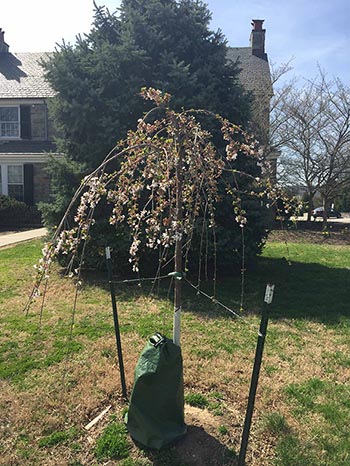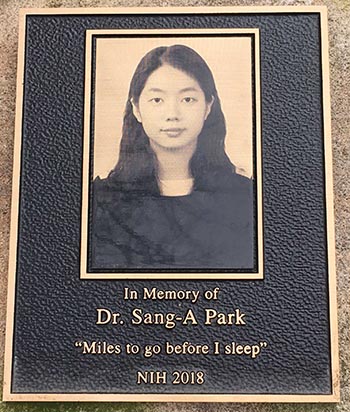Memorial Trees
Honoring People

Kousa dogwood (Cornus kousa) blossoms
Of the over 8,000 trees on the Bethesda campus, 24 are memorial trees and 50 are commemorative trees. Memorial trees honor people; commemorative trees honor an institute, department achievement, or milestone.
The most recent memorial tree is a kousa dogwood (Cornus kousa), planted last year in memory of Sang-A Park, a native of South Korea, who came to NIH in 2016 as a visiting postdoctoral fellow in the National Institute of Dental and Craniofacial Research’s Mucosal Immunology Section. She died after being hit by a car on campus in January 2018. Her tree is native to China, Japan, and Korea. In late spring, it will produce white flowers in the courtyard west of Building 30, the building where she once worked.
Like the other deciduous trees on campus, these special trees grow and change with the seasons, blooming in the spring and dropping their leaves in the fall. What differentiates them is the presence of a small plaque with an inscription, usually located on a stone near the base of the tree.

A weeping Higan cherry tree was planted in memory of Ellis McKenzie and is located north of the the Lawton Chiles International House (Building 16).
The first memorial tree was donated in the late 1980s in honor of George F. Cahill Jr., when he retired as director of the Howard Hughes Medical Institute-NIH Research Scholars Program. The second tree, planted on World AIDS Day in 1994, was in remembrance of tennis great Arthur Ashe, who died due to complications from AIDS. But most of the memorial trees have been planted in memory of deceased individuals who were members of the NIH community.
Memorial trees are located across the campus, but there are clusters in the green space north of the Natcher Conference Center (Building 45) and on the grounds near the Cloister (Building 60). The area behind Natcher is wooded with a diverse population of trees, so many trees fit well into the landscape. Brandon Hartz, NIH’s landscape architect, says he takes a holistic view when guiding the donors through the approval procedure for what kind of tree to plant and where.
The multistage approval process includes consideration of NIH construction, physical characteristics of the tree, and harmony with the surrounding landscape. To comply with guidelines, Hartz consults with colleagues in the Office of Research Facilities Division of Facilities Planning.
The guidelines also take into account the physical properties such as a tree’s diameter at breast height (DBH), which is the diameter of the tree measured at 4.5 feet above the ground. Small-diameter trees require more maintenance and are more prone to harm from lawnmowing and wildlife. Larger-diameter trees are heartier but do not establish their roots as quickly. A DBH of two to four inches is generally the sweet spot. Ensuring harmony with the existing landscape requires thinking about how a tree would complement or contrast with existing features.
One example for how to fit a tree into an existing landscape is the memorial tree—a weeping Higan cherry (Prunus subhirtella) tree—planted in 2017 in memory of Ellis McKenzie, a senior scientist at the Fogarty Center. Hartz suggested planting the tree north of the Lawton Chiles International House (Building 16), where it would be a focal point in the landscape. It’s the only pink flowering tree in the area and, in the spring, its pink flowers will complement the nearby white-flowering hawthorns. In addition, its weeping shape contrasts nicely with the conical shapes of the nearby blue spruce and horizontal branches of hawthorns.

CREDIT: ADRIAN CARCAMO, NCI
The plaque for the kousa dogwood planted in the courtyard west of Building 30 reads “In memory of Dr. Sang-A Park ‘Miles to go before I sleep.’ NIH 2018.”
This spring, when you are enjoying the beauty of emerging blossoms or sitting under the shade provided by the leaves of a nearby tree, check to see whether the tree has a small plaque next to it. If it does, it is likely a memorial tree, planted in honor of those members of our community who, although gone, will not be forgotten.
For more information on the policies for memorial and commemorative trees, go to https://policymanual.nih.gov/1450.
This page was last updated on Tuesday, April 5, 2022
